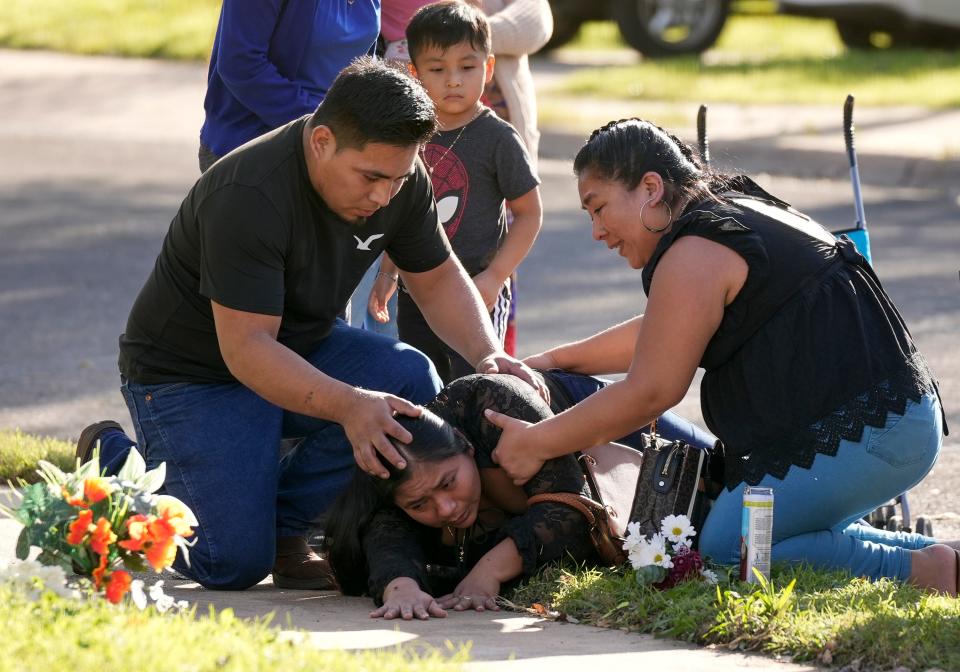Homicides in Austin stayed the same in 2023 as in the previous year. Here's what we know.
Editor's note: This story has been updated to clarify how many Texas cities have higher homicide rates than Austin.
It was late on a summer night in early June. With moving boxes still stacked up throughout the North Austin apartment, as the family had only moved there weeks before, Mikalah Franklin did what many 14-year-olds do over summer vacation: She stayed up late with her friends and siblings.
At nearly 1 a.m., the time came for one of her friends to leave. They walked her out to meet her Lyft after getting permission from Franklin's mom, Tenisha Guajardo.
Almost immediately, the gunshots started. One and then another, and another, and another. So many shots that it "seemed like forever," Guajardo said.
Guajardo ran outside and found Franklin's siblings, including her 5-year-old son, who was covered in blood. But it wasn't his blood; it was Franklin's. Guajardo found her daughter bleeding in the bed of her grandmother's truck. After calling 911, Guajardo fainted.
"I just knew that she wouldn't make it," Guajardo said. "After that, I just felt disbelief. For two months it didn't feel real. I just couldn't accept it."

She was killed by a gunman who didn't even know her, according to police, in what her family believes was a case of mistaken identity. Almost two months later, Austin police arrested Micah Marshall, 17, and charged him with first-degree murder in Franklin's death.
The killing was one of Austin's 66 homicides in 2023, according to data obtained by the American-Statesman through an open records request. That number, the same as in 2022, represents a violent streak that has not dipped to pre-pandemic numbers.
Austin has seen a noticeable increase in homicides since the pandemic began. They went up in cities nationwide during the pandemic, but most have continued to see drops since 2021.
Austin hasn't been much different. Homicides shot up 33% in 2020 from the previous year. Those numbers skyrocketed 80% in 2021, the same year the city broke its record for number of slayings with 79. In 2022, as the pandemic receded they dropped 16%.
But while preliminary data shows a "sharp decline" in homicides in cities across the country in 2023, according to The New York Times, Austin's stayed the same.
Even with the higher numbers since 2020, Austin's homicide rate has stayed below its record-breaking rate of 1984, when there were 13.2 homicides per 100,000 people, according to police records going back to 1960.
Austin's homicide rate of 6.8 per 100,000 people puts it lower than three of the eight Texas cities with populations of more than 300,000.
The city also had an unusual year for homicides in 2023. Seven occurred in just two incidents near the end of the year. One was at a home in South Austin and left a SWAT officer dead along with two other people in November. The other came last month when a man drove up from the San Antonio area and killed four people in Austin, according to police.
Sgt. Nathan Sexton of the Austin police homicide unit said the Dec. 5 slayings are the most people to have been killed by a single person on the same day in Austin since the yogurt shop murders in 1991.
Incidents such as the Dec. 5 slayings are rare, he added, as most people are killed by someone they know, with the majority tied to other criminal activity, such as a drug deal gone wrong. A "small percentage" of slayings are family violence cases, he said.

In an interview this month, Sexton said only three homicides remained unsolved, but that police had leads on all of them. If each one is solved, Austin police would reach a 100% clearance rate for only the fourth time since 1980.
However, the number of homicides could rise or fall, depending on whether another discovery in a case changes its status.
As for 2024, Sexton thinks the numbers could stay about the same.
"Just based on the past two years, it kind of seems like that's unfortunately the new norm," he said. "Of course, we always hope that it's going to go back down again."
More: ‘He was the best father’: Death of man in Austin shootings leaves family unsure of future
What's the demographic breakdown of those killed?
The 18 to 29 age group had more homicide victims than any other, making up 33% of those killed, according to data provided by the Austin Police Department.
Here's a breakdown of homicides for the other age groups:
Four were under 18.
Sixteen were in their 30s.
Eleven were in their 40s.
Six were in their 50s.
Seven were 60 or over.
Twenty-four of the people slain in Austin last year were Black, more than any other demographic, according to police records. The Black population makes up only 8% of the city's total, according to the U.S. Census Bureau, but it included 36% of those who were killed.

Hispanic people were the next-largest demographic of people slain, accounting for a third of those killed — a number that's proportional to the population in Austin.
White people accounted for less than a quarter of those killed, despite making up 48% of the city.
Seventy-six percent of those killed were men, according to data from the Austin Police Department.
January was the deadliest month last year, police data showed, with nine homicides. Nineteen killings happened on Tuesdays, making it the deadliest day of the week.
The vast majority of people were killed with a gun, Sexton said. About 12 were killed by something other than a gun.
Mother of homicide victim grapples with loss
Guajardo said Franklin was an old soul, someone who was always protective of her family and friends. Her principal, who spoke at her funeral, called her the school's mom.
Franklin was silly and incredibly loving, Guajardo said, remembering how she and her cousin used to dress up and knock on her door wearing fun costumes and how she would walk her little brother to school when she didn't have to.
It took Guajardo two months before she began to accept the reality of what had happened: Her oldest daughter was dead, gunned down by someone who didn't even know her, according to police.
The suspect in Franklin's death was able to get out of jail after his bail amount was lowered from $1 million to $250,000.
Every day, Guajardo experiences something different: Some days it's so much anger that she wants to break something. Some days she wakes up crying. On others, she wonders, "What if I hadn't let the kids go outside?"
Guajardo is seeking counseling for her other five children, and she suffers from post-traumatic stress disorder.
She remembers asking her daughter what she wanted to do when she grew up. Franklin would laugh and say, "I got my whole life ahead of me to figure that out."
This article originally appeared on Austin American-Statesman: Here's how homicides in Austin in 2023 compared with previous years

